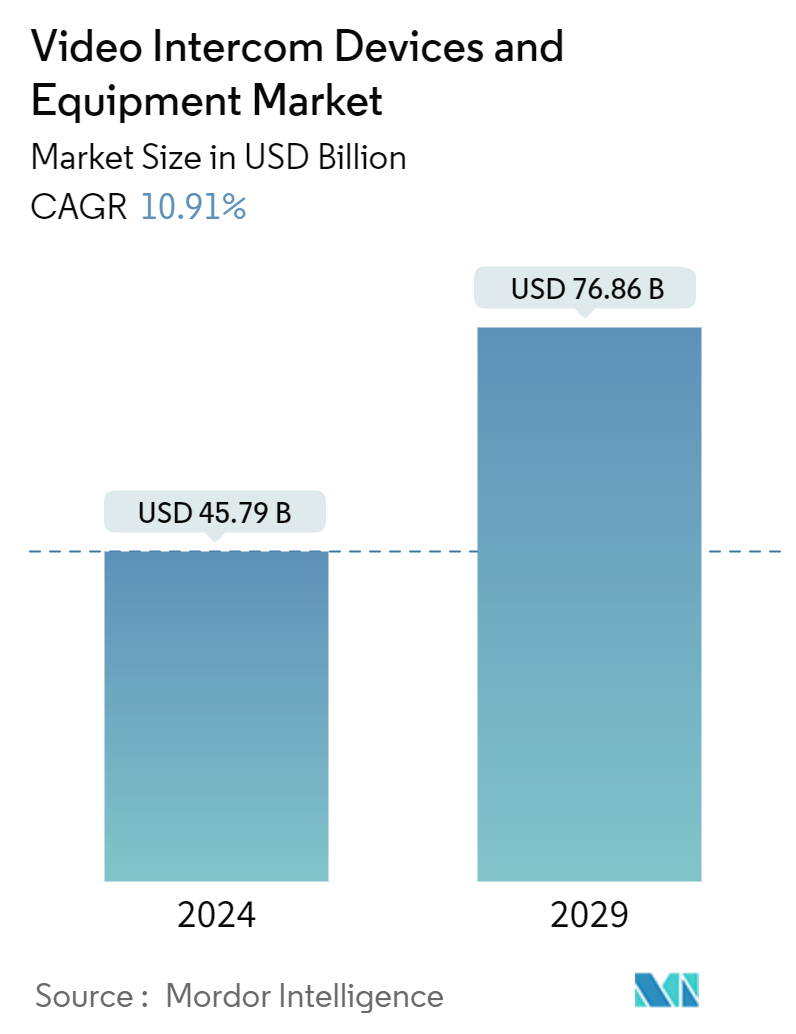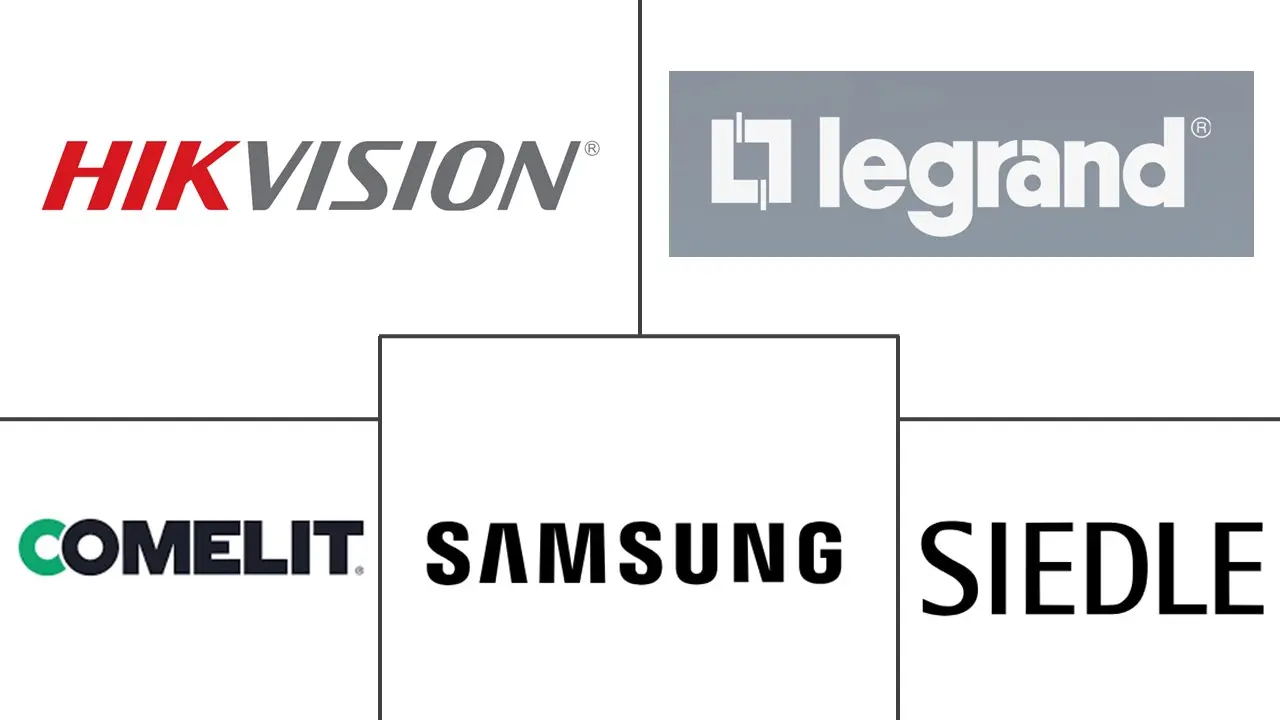Market Size of Video Intercom Devices And Equipment Industry

| Study Period | 2019 - 2029 |
| Market Size (2024) | USD 45.79 Billion |
| Market Size (2029) | USD 76.86 Billion |
| CAGR (2024 - 2029) | 10.91 % |
| Fastest Growing Market | Asia Pacific |
| Largest Market | North America |
Major Players
*Disclaimer: Major Players sorted in no particular order |
Video Intercom Devices Market Analysis
The Video Intercom Devices And Equipment Market size is estimated at USD 45.79 billion in 2024, and is expected to reach USD 76.86 billion by 2029, growing at a CAGR of 10.91% during the forecast period (2024-2029).
- The increasing demand for video intercom devices in the security and surveillance industries will likely drive market expansion during the forecast period. Video intercom systems are commonly used as audiovisual communication systems at entry-exit points of offices, organizations, and buildings, among other places.
- Globally, smart cities are growing as urbanization picks up speed. According to the United Nations, India (404 million), China (292 million), and Nigeria will each have an extra 212 million urban dwellers by 2050. The highest pace of urbanization is observed in the emerging continent of Latin America, which would drive the demand for smart buildings and proportionately drive the need in the market.
- Globally, many smart city projects and efforts are being implemented, encouraging global investments owing to urbanization. The OECD (Organization for Economic Co-operation and Development) predicts that between 2010 and 2030, worldwide investments in smart city initiatives will total around USD 1.8 trillion for all metropolitan city infrastructure projects. Such a rise in smart cities would allow the market to grow.
- Incorporating new technologies in video intercom devices is expected to drive the market. For example, with AI, video intercom devices can have facial recognition, voice recognition, and behavior analysis features. Also, AI-powered intercom devices can utilize natural language processing and machine learning to improve communication. They can understand and respond to voice commands, providing a smoother user experience. These devices also learn from user interaction, adapting to preferences and making more accurate predictions and suggestions.
- Technological advancement has led to the adoption of video intercom systems as organizations in the commercial sector are looking for sophistication in terms of security features and ease of convenience. In the residential segment, the rise of smart homes has largely impacted the need for innovative technological prowess in the devices and equipment to provide a unified and smart security system. Technological advancements can be seen in the newly launched products for both sectors. The focus on high-quality video, audio, and vandalism-resistant products is gaining significant traction.
- Also, as new infrastructure comes up in the residential and commercial sectors, the high focus on advanced video surveillance alongside the ease of convenience is anticipated to drive the market's growth. Data centers, for instance, are expected to witness high growth rates since security is one of their primary concerns.
- Also, the market is anticipated to benefit greatly from the expanding popularity of smart homes. Various government initiatives to create smart cities are also anticipated to fuel market growth. The market is expanding due to the introduction of sophisticated security audiovisual systems that offer offices and residential buildings a higher level of security.
- The extremely high rate of hacking poses a barrier to the industry being researched because people are concerned about how it may affect the security and safety of homes and businesses. In addition, compromising network security exposes the infrastructure's overall security. However, tight security regulations and developments are anticipated to alleviate the issues brought on by the worry about hacking.
Video Intercom Devices Industry Segmentation
Video intercom devices use video methods and are stand-alone intercom systems used to manage calls made at the entrance to a building with access control. The diversity of video intercom devices and equipment applications has added security and comfort in commercial, residential, and industrial applications. The study tracks the revenue generated by vendors through device offerings among end users.
The video intercom devices market is segmented by technology (analog and IP-based), end user (commercial, residential, government, and other end users), and geography (North America, Europe, Asia-Pacific, Latin America, and Middle East and Africa). The market sizes and forecasts are provided in terms of value (USD) for all the above segments.
| By Technology | |
| Analog | |
| IP-based |
| By End User | |
| Commercial | |
| Residential | |
| Government | |
| Other End Users |
| By Geography*** | |
| North America | |
| Europe | |
| Asia | |
| Australia and New Zealand | |
| Latin America | |
| Middle East and Africa |
Video Intercom Devices And Equipment Market Size Summary
The video intercom devices market is poised for significant growth, driven by the increasing demand for enhanced security and surveillance solutions across various sectors. As urbanization accelerates globally, the rise of smart cities is creating a burgeoning need for advanced video intercom systems, which serve as crucial components in the security infrastructure of smart buildings. The integration of cutting-edge technologies such as artificial intelligence, natural language processing, and machine learning is further propelling the market, offering features like facial and voice recognition that enhance user experience and security. The shift from analog to IP-based solutions is also gaining momentum, particularly in commercial spaces, as businesses seek to modernize their access control systems and improve security measures at entry and exit points.
North America stands out as a significant player in the video intercom devices market, bolstered by its robust home automation sector and substantial investments in smart city initiatives. The region's focus on enhancing security through advanced video surveillance systems is driving market expansion, supported by government funding and commercial sector investments in smart buildings. The market is characterized by a high degree of fragmentation, with both global and regional players competing through strategic partnerships and technological innovations. Recent developments, such as Hikvision's launch of a new intercom solution and ButterflyMX's next-generation systems, highlight the ongoing advancements and competitive dynamics within the industry, setting the stage for continued growth and adoption of video intercom technologies.
Video Intercom Devices And Equipment Market Size - Table of Contents
-
1. MARKET INSIGHTS
-
1.1 Market Overview
-
1.2 Industry Attractiveness - Porter's Five Forces Analysis
-
1.2.1 Threat of New Entrants
-
1.2.2 Bargaining Power of Buyers
-
1.2.3 Bargaining Power of Suppliers
-
1.2.4 Threat of Substitutes
-
1.2.5 Intensity of Competitive Rivalry
-
-
1.3 Industry Value Chain Analysis
-
1.4 Assessment of Macro-economic Factor and its Impact on the Market
-
-
2. MARKET SEGMENTATION
-
2.1 By Technology
-
2.1.1 Analog
-
2.1.2 IP-based
-
-
2.2 By End User
-
2.2.1 Commercial
-
2.2.2 Residential
-
2.2.3 Government
-
2.2.4 Other End Users
-
-
2.3 By Geography***
-
2.3.1 North America
-
2.3.2 Europe
-
2.3.3 Asia
-
2.3.4 Australia and New Zealand
-
2.3.5 Latin America
-
2.3.6 Middle East and Africa
-
-
Video Intercom Devices And Equipment Market Size FAQs
How big is the Video Intercom Devices And Equipment Market?
The Video Intercom Devices And Equipment Market size is expected to reach USD 45.79 billion in 2024 and grow at a CAGR of 10.91% to reach USD 76.86 billion by 2029.
What is the current Video Intercom Devices And Equipment Market size?
In 2024, the Video Intercom Devices And Equipment Market size is expected to reach USD 45.79 billion.

